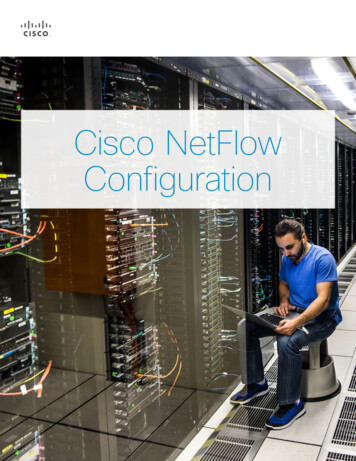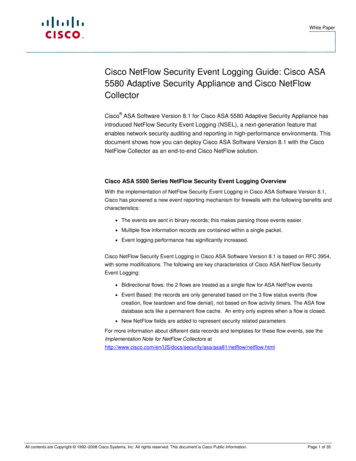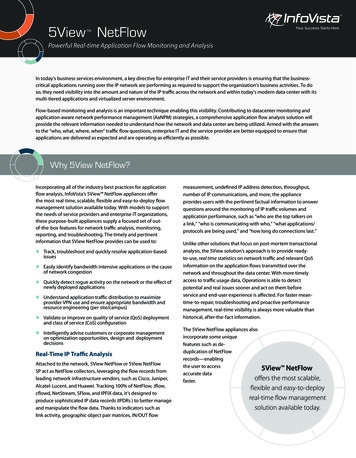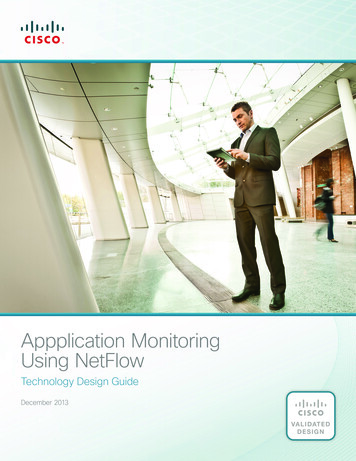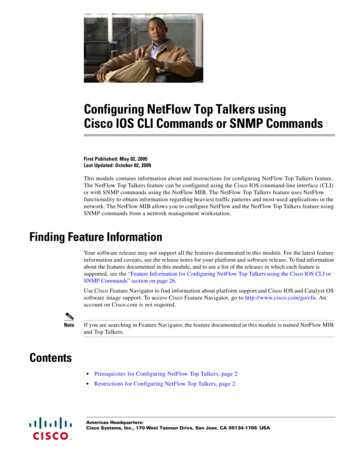
Transcription
Cisco IT Case StudyNetwork Capacity PlanningHow Cisco IT Uses NetFlow to Improve Network CapacityPlanningNetwork management capacity planning saves money and improvesperformance across Cisco.Cisco IT Case Study / Network Management / Network Capacity Planning: This case study describesCisco IT’s network capacity planning process and its internal deployment of Cisco IOS NetFlow and third-partysolutions within the Cisco network, a leading-edge enterprise environment that is one of the largest and mostcomplex in the world. Cisco customers can draw on Cisco IT’s real-world experience in this area to helpsupport similar enterprise needs.“Having tools that allow us to identifythe applications consuming bandwidthis absolutely indispensable. Agranular view of what’s happening inour network has allowed us toforecast our need for additional WANlinks and budget effectively severalquarters out.”– Joe Silver, Cisco IT Project ManagerBACKGROUNDOf all the issues faced by enterprise companies in managingtheir networks, capacity planning is one of the most important.More an art than a science until recently, network capacityplanning is all about balancing the need to meet userperformance expectations against the realities of capitalbudgeting.WAN bandwidth is expensive. Many companies—and CiscoSystems is no exception—attempt to control costs byacquiring the minimum bandwidth necessary to handle trafficon a circuit. Unfortunately, this strategy can lead to congestionand degraded application performance.A WAN circuit running at 80 percent of capacity is too full. Even a circuit that averages 60 percent of capacity maywell peak at 95 percent of capacity for several periods during a day, reducing user productivity and negativelyaffecting business activities. Many IT organizations order new circuits (which can take anywhere from 30 to 90 daysto deploy) when a circuit operates at 60 to 80 percent of capacity.As recently as 2000, Cisco relied almost exclusively on Simple Network Management Protocol (SNMP) to monitoroverall WAN bandwidth utilization. Measuring overall traffic, however, does little to characterize network traffic, whichis essential to deciding if additional capacity is warranted. Without knowing what types of traffic are using the network,it is impossible to know if quality of service (QoS) parameters for applications such as voice or video support targetservice levels. Complicating the challenges of traffic characterization is the reality that many new applications use arange of dynamic ports. These dynamic ports may also be used by several different applications within the enterprise.CHALLENGEThrough the late 1990s, Cisco operated only 140 Frame-Relay-based WAN sites in the United States. Bandwidthcapacity was sub T-1. However, in 2000, WAN utilization began to increase rapidly, doubling every 12 to 18 months,degrading application performance, and affecting business operations.Driving bandwidth consumption were voice over IP (VoIP, or Internet telephony) and video on demand (VoD), whichshare the network with more conventional uses, including e-mail, Internet access, and PC backups. Frequently, CiscoAll contents are Copyright 1992–2007 Cisco Systems, Inc. All rights reserved. This document is Cisco Public Information.Page 1 of 7
Cisco IT Case StudyNetwork Capacity PlanningIT engineers found that traffic congestion on some network links had significantly reduced user productivity.Though IT knew that traffic was increasing exponentially and that actual usage was not in line with expectations, it didnot have access to the level of detail necessary to understand the true nature of problem. This made it almostimpossible to make informed decisions about bandwidth upgrades.“Cisco had no clearly established proactive capacity planning process,” says Keith Brumbaugh, Cisco IT GlobalNetwork Engineer. “We tended to implement upgrades in reaction to internal customer complaints rather than soliddata. And in the early 2000s we were finding ourselves overwhelmed by the traffic from new applications such asvoice and video. We were particularly concerned, because VoIP is sensitive to latency and jitter. Poor voiceperformance in our environment could detract from its business value.”From experience, the network capacity planning team knew that a few applications can consume most of the WANbandwidth on a given network segment. Further, the team knew that with visibility into the top 10 applications, alongwith the top 10 traffic pairs, it was possible to accurately identify and characterize 70 percent or more of networktraffic. Any one of these top 10 applications can occupy 10 percent or more of a segment’s bandwidth—and whenanalysis extends beyond these applications, it shows that consumption quickly fades. In fact, any application not inthe top 10 probably uses less than one percent of available bandwidth. “Almost half of Cisco IT’s WAN backbonetraffic consists of data backup such as database syncs, server-to-server, PC backup, and SnapMirror, which is usedto back up engineering data,” says Brumbaugh.QoS: An AsideA surprising number of IT staff at large enterprises believe that networks built with high-capacity switches, multigigabit backplanes, and high-speed LAN and WAN links should never need QoS management. They believe that themore bandwidth available, the less QoS is needed. All networks have congestion points where data packets can bedropped—WAN links where a larger trunk funnels data into a smaller one, or a location where several trunks funneldata into fewer outputs (Figure 1). Applying QoS does not create additional bandwidth. Rather, it helps smooth thepeaks and valleys of network circuit utilization. QoS provides more consistent network performance from the point ofview of users.Figure 1.Congestion Point ExamplesAll contents are Copyright 1992–2007 Cisco Systems, Inc. All rights reserved. This document is Cisco Public Information.Page 2 of 7
Cisco IT Case StudyNetwork Capacity PlanningFrom a capacity planning standpoint, deploying QoS uniformly across the network protects important real-time voiceand video applications—guaranteeing bandwidth and/or low latency—from occasional traffic spikes that can affectperformance. Because of this measure of protection, Cisco IT planners believe that QoS settings must be deployedglobally on all appropriate network devices in order for capacity planning to be fully effective.Cisco planners also discovered that while most capacity planning occurs at the circuit level, it is also desirable wherepossible to plan within individual classes of service. It is possible to oversubscribe one or more classes of servicewithout reaching utilization levels that would affect a circuit’s overall performance. It is especially important to do thistype of planning when using WAN technologies such as Multiprotocol Label Switching (MPLS), virtual privatenetworks (VPNs), or Asynchronous Transfer Mode (ATM). Carriers, in addition to charging for a circuit, also chargefor these classes of service. Managing the bandwidth levels of these individual classes of service ensures properapplication performance without overspending for a particular class of service.SOLUTIONCategorizing Network TrafficCisco IT began its efforts toward improving the capacity planning process by categorizing network traffic into threetypes: Legitimate, business-related traffic – Companies build their networks to accommodate legitimate, businessrelated traffic. If a link is at capacity and all traffic is legitimate, then a network upgrade may be necessary. Afactor influencing this decision is that some legitimate traffic, such as backups, file transfers, or VoDreplication, can be scheduled outside of peak utilization hours. The ability to make scheduling changes canoften postpone the need for an upgrade. “When we first implemented a new application to back up user PChard drives across the network, we seriously underestimated the impact it would have on the WAN—especially smaller branch WAN links,” says Joe Silver, Cisco IT Project Manager. “While backups were doneincrementally, the initial backup was always large—and when we first deployed the application, they were allinitial backups. After looking at the performance problems, and realizing they were created by a legitimateapplication that would eventually stop needing so much bandwidth, we decided to avoid WAN upgrades.Instead, we asked the application developers to schedule all initial backups after hours. When they did, theproblem was solved.” Inappropriate traffic – Traffic in this category can include everything from recreational Internet downloads toviruses, worms, or distributed denial of service (DDoS) attacks. Capacity planners have discovered that it isnot important or even desirable to eliminate recreational traffic entirely, until it begins to significantly affectbandwidth availability and compete with the top 10 applications. Investigating and eliminating inappropriatetraffic may postpone the need for bandwidth upgrades while improving performance for business-relatedactivities. “At one point, one of our larger offices was running into performance problems, which we eventuallytraced to one person who was uploading and downloading a tremendous number of files at work,” saysBrumbaugh. “Because this was not business-related, we talked directly with that individual about Cisco’spolicy regarding non-work-related behavior. The performance problems cleared right up.” Unwise traffic – Harder to describe than inappropriate or legitimate traffic, unwise traffic can result from howand where business-related applications are used. Backups or database synchronizations performed atinappropriate times or over inappropriate segments of the network are obvious offenders. Traffic consumingsignificant bandwidth during peak hours that can be safely moved or rescheduled is unwise traffic.Determining which traffic fits this category is the responsibility of the capacity planning engineer. In manycases, applying standard QoS configurations automatically slows unwise traffic by marking it “scavengerclass” and not allowing it to impinge on other traffic during hours of peak use. Interestingly, unwise traffic is notnecessarily scavenger-class traffic. During traffic analysis, capacity planning engineers can choose toreschedule, eliminate, or categorize traffic as scavenger-class. “Clients were complaining about WANAll contents are Copyright 1992–2007 Cisco Systems, Inc. All rights reserved. This document is Cisco Public Information.Page 3 of 7
Cisco IT Case StudyNetwork Capacity Planningperformance between our Irvine office and headquarters in San Jose,” says Silver. “After the analysis, wedetermined that the circuit was congested with SnapMirror backup traffic. SnapMirror backs up servers in thedata center and is not considered mission-critical. Working with the backup team, we decided to categorizebackups as scavenger-class, which allowed them to be throttled back during times of congestion. We avoideda bandwidth upgrade, and overall WAN performance improved immediately.”Capacity planning should provide volume and content traffic information to network architects, designers, andoperators—making it possible to size the network accurately while meeting business requirements. Capacityplanning should also provide management and finance executives with the data required for budgeting andforecasting by pointing out which connections are approaching saturation and will require an upgrade.Sizing and Utilization GuidelinesCisco planners believed it was vital to establish sizing and utilization guidelines to serve as baselines for managingnetwork capacity (Tables 1 and 2). The planning team found that initial sizing guidelines based on headcount wereappropriate for most Cisco field sales offices. However, bandwidth generalizations were not always appropriate forsome engineering and extranet sites and Internet POP locations. These types of locations required evaluation on asite-by-site basis. Equally important, planners realized that while guidelines were important, they did not eliminate theneed for an engineering analysis to ensure that the bandwidth solution was appropriate for each location.Table 1.Sample Initial Sizing ChartHeadcountPrimary WAN BandwidthSecondary WAN Bandwidth1–101.5 MbpsNone11–401.5 Mbps1.5 Mbps41–1003 Mbps3 Mbps101–1504.5 Mbps4.5 Mbps151–2006 Mbps6 Mbps201–50045 Mbps6 Mbps501 155 Mbps45 MbpsTable 2.Sample Utilization Threshold Chart* Percentage Utilization(Watch/Analyze)** Percentage Utilization (Upgrade)Primary/Backup WAN Bandwidth*** 100/10060%80%**** 100/5040%50%***** 50/5040%50%*15-minute average threshold exceeded 10 percent or more during local business hours (monthly)**15-minute average threshold exceeded or equaled 20 percent of local business hours (monthly)***Primary circuit handles 100-percent of the traffic until failure, when the backup takes over****Primary circuit handles 100 percent of the traffic until failure, when the backup takes over with 50 percent ofthe capacity of the primary***** Primary and backup circuits load-share until a failure occursAll contents are Copyright 1992–2007 Cisco Systems, Inc. All rights reserved. This document is Cisco Public Information.Page 4 of 7
Cisco IT Case StudyNetwork Capacity PlanningWhether provisioning bandwidth at a new location or deciding when to upgrade an existing circuit, Cisco plannerswere acutely aware that their decisions must be cost-effective. Though established guidelines were usuallyappropriate, planners found that in some locations, higher-bandwidth circuits were less expensive than lowerbandwidth solutions. In these cases, capacity planners based decisions on cost, rather than the bandwidth actuallyrequired.The ToolsCisco characterized, analyzed, and detected anomalies in network traffic flows using Cisco IOS NetFlowtechnology, including NetQoS ReporterAnalyzer, their selected third-party reporting solution. This solution used thedata captured by Cisco IOS NetFlow to report on network traffic.Cisco IOS NetFlow (Figure 2) has become the primary network accounting and anomaly detection technology in thenetwork industry. In fact, in 2003, Cisco IOS NetFlow Version 9 was chosen for a proposed IETF standard, the IPFlow Information Export (IPFIX). IPFIX defines the format by which IP flow information is transferred from anexporter, such as a Cisco router, to an application that analyzes the data.Figure 2.Overview of Cisco IOS NetFlow“Essentially, we turned on NetFlow with no negative impact to the network,” says Brumbaugh. “It didn’t create CPU ormemory problems on routers, and collecting the data didn’t saturate our WAN links. We never used probes—they areintrusive, and there tend to be scalability issues. We selected NetQoS as our capacity planning application largelybecause it took advantage of the Cisco IOS NetFlow capability present on all our routers.”“NetFlow also saved us time,” adds Silver. “Though the system does require some attention, it is minimal comparedto what we had to do five years ago. Back then, our IP accounting system was very hands-on. It could take 20 hoursto harvest data—20 very tedious hours—and the results were often poor. Now, we get detailed data in a matter ofminutes.”All contents are Copyright 1992–2007 Cisco Systems, Inc. All rights reserved. This document is Cisco Public Information.Page 5 of 7
Cisco IT Case StudyNetwork Capacity PlanningReportingCisco regularly performs capacity planning on existing locations, though it is currently not practical to perform detailedongoing analysis on every circuit. Reports generated by Cisco IOS NetFlow, plus size and utilization guidelines, helpplanners determine the circuits they must watch and where bandwidth augmentation is necessary. Global capacityplanners are alerted proactively when circuits reach established thresholds via daily, weekly, and monthly reports thathighlight circuits above the established “watch/analyze” threshold of 60-percent utilization for 10 percent or more oflocal peak traffic hours.RESULTSWhen the capacity planning team determines that bandwidth augmentation is necessary, it provides arecommendation to Cisco IT’s network operations, where it is reviewed by IT network engineers and managers. Onceit is determined that an upgrade is necessary, proceeding with the upgrade becomes a business decision. “I’d beenseeing a steady increase in bandwidth utilization on our circuit to India over the past 12 months,” says Brumbaugh. “Iknew that if it continued at that rate, the link would be saturated quickly. Because I knew at a granular level what thetraffic was, I could comfortably help build a business case for increasing bandwidth. It’s great to work with realinformation.” After going through Cisco IT’s network design process, the architects and engineers in IT decided theyneeded to begin a major upgrade in the design of the Cisco India WAN and the backbone links connecting India tothe rest of the world.In addition to providing business decision makers with hard data and communicating with them more effectively,Cisco capacity planners can now prioritize and manage deployments better—delivering bandwidth beforeperformance deteriorates and productivity decreases. A coherent planning process has also made it easier tounderstand the impact of application rollouts. The result has been an improved relationship with the applicationteam—both groups can better plan and budget activities that affect each other’s operations.LESSONS LEARNED“We’re guessing that many of the problems we experienced are shared by 99 percent of the enterprises out there,”says Silver. “What we learned, very simply, is that attempts to plan network capacity without appropriate tools areinaccurate and expensive. We knew that we needed to improve both our tools and our processes—and when we did,we realized that the money we spent implementing NetFlow was low in relation to the amount we had been spendingwithout it.”NEXT STEPSThe Cisco capacity planning team plans to use Cisco IOS NetFlow technology to develop an even more detailed viewof network traffic. In a MPLS environment, where the enterprise pays its bandwidth circuit providers differentially fordifferent classes of service, it is important not to pay for service that is unnecessary. By monitoring and reporting onclasses of service at a deeper level, Cisco expects to be able align what it pays for service with what is actuallyneeded, saving significantly going forward.All contents are Copyright 1992–2007 Cisco Systems, Inc. All rights reserved. This document is Cisco Public Information.Page 6 of 7
Cisco IT Case StudyNetwork Capacity PlanningFOR MORE INFORMATIONTo read the entire case study or for additional Cisco IT case studies on a variety of business solutions, visit Cisco onCisco: Inside Cisco IT www.cisco.com/go/ciscoitNOTEThis publication describes how Cisco has benefited from the deployment of its own products. Many factors may havecontributed to the results and benefits described; Cisco does not guarantee comparable results elsewhere.CISCO PROVIDES THIS PUBLICATION AS IS WITHOUT WARRANTY OF ANY KIND, EITHER EXPRESS ORIMPLIED, INCLUDING THE IMPLIED WARRANTIES OF MERCHANTABILITY OR FITNESS FOR A PARTICULARPURPOSE.Some jurisdictions do not allow disclaimer of express or implied warranties, therefore this disclaimer may not apply toyou.All contents are Copyright 1992–2007 Cisco Systems, Inc. All rights reserved. This document is Cisco Public Information.Page 7 of 7
Cisco IT Case Study / Network Management / Network Capacity Planning: This case study describes Cisco IT's network capacity planning process and its internal deployment of Cisco IOS NetFlow and third-party solutions within the Cisco network, a leading-edge enterprise environment that is one of the largest and most .


